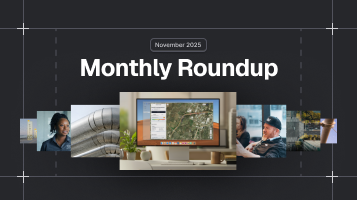Ultimate List of Underground Utilities - What Can You Find Underground?
Written by

Published on
November 7, 2022


Table of contents
Construction projects require a lot of planning and coordination between different entities. Not surprisingly EPC (Engineering Procurement Construction) project managers need to ensure that digging and excavation permits have been received from the authorities.
811 is a designated service in the USA that helps companies to identify and mark known underground utility lines. Although it is not a perfect service, 811 can help discover multiple utility lines under the surface. In most states, including in Texas, it is legally required to call 811 and map the designated area for existing subsurface utilities.
Modern utility mapping tools are more reliable.
More modern utility mapping tools, such as what 4M Analytics offers its customers, can identify both known and unknown utilities in a non-invasive manner. Such utility mapping tools and data are made with cutting-edge technologies, such as artificial intelligence, machine learning, and remote sensing.
However, one might wonder what type of underground utilities one may find under the area to be excavated. In this article, we list the most important types of utilities that are commonly found underground.
1. Television or communication cables
Communication cables are often buried just under the surface, making it risky to dig without knowing precisely where they are. While telephone and TV cables are a part of this infrastructure, fiber optic cables are increasingly becoming common too. Damage to these cables can result in repair costs, damages that need to be paid for downtime, and lengthy legal battles with telecom companies.
2. Gas pipes
Gas pipes may carry fuel and liquified gas, and digging around them can be hazardous to workers and communities nearby. Although most gas pipelines are easily identifiable, some may be left abandoned. They often have warning tapes 12 to 18 inches above them, but there is always a risk of damaging them, leading to disasters. It is essential to mark known and unidentified gas mains before one starts to dig.
3. Metal and concrete pipes
Older metal and concrete pipes may carry water. They may be made from wrought iron, galvanized iron, and cast iron. In addition to water, they may also carry sewage and gas. Many of these older pipes may not have been registered with organizations such as 811, and identifying them accurately is crucial for safe excavation.
4.Sewer lines
Both inhabited and uninhabited areas can have sewer lines fixed underground. Digging around sewers is dangerous if one does not know their accurate position or if they overlap over water mains. Damage to sewer lines can have disastrous effects. In addition to contaminating soil and possibly flooding communities, it can enter water mains and result in health hazards.
5. Water pipes
There is an extensive network of water pipes across Texas, and damage to these water pipelines and mains can result in extensive damage to property and life. Not surprisingly, authorities take damage to water pipes very seriously, and you will be responsible for both repairs and compensations. Hence, it is imperative to know the exact location of water mains and lines. These include pipes that carry water for drinking purposes, irrigation, and commercial usage.
6. Electric lines
Although many regions have overhead electric lines, it is more common to find underground power cables in some areas. Digging around subsurface electrical infrastructure can potentially harm workers and cause power outages to nearby communities if damage occurs. Hence, identifying and marking existing buried electric cables is very important.
What are the common underground utility location methods?
There are several ways to detect buried utility infrastructure. Here are a few:
1. Electromagnetic utility locating
Electromagnetic utility locating is the most popular technique to locate underground utilities. One can use it to detect electric, telephone, water, sewer, gas, and irrigation lines. However, it cannot identify asbestos, concrete, terracotta, or plastic utility lines. The associated equipment has been around for a while and helps detect conductive subsurface utilities by using electromagnetic radio frequency.
2. Ground Penetrating Radar (GPR) Technology
GPR uses high-frequency radio wave pulses to detect objects and utilities that cannot be typically identified by electromagnetic utility locating. It is perfect for discovering and identifying buried things, tanks, cables, and pipes missed by other techniques. Unfortunately, GPR antennas do not penetrate deep, and specific soils that are saline or clayish limit their ability to detect utilities.
3. Vacuum excavation
Vacuum excavation, also known as hydro excavation, is a minimally invasive technique in which underground utilities are detected using high-pressure air to penetrate the soil. This soil is vacuumed into a chamber safely and securely. However, the process is invasive and may fall into a legally gray area.
4. Dowsing
Dowsing is an unproven method of detecting utility lines and subsurface infrastructure using sheer intuition and dowsing rods. These rods are sometimes made from coat hangers and apparently can see active pipelines. This isn’t an accurate method to detect subsurface infrastructure.
How does one find buried utility lines in a project area?
Today, identifying buried utility lines has become more tech-savvy. Although one is legally required to call 811 and let them do their job, there are better alternatives that help detect abandoned and unidentified utilities accurately.
In addition, advanced utility mapping solutions equipped with satellite imagery, machine learning (ML) and artificial learning (AI) technologies such as 4M Analytics’ solutions can help create a reliable representation of subsurface infrastructure remotely. A project manager’s best bet is an advanced utility mapping solution to find buried utility lines in a yard.
Contact a professional from 4M Analytics in Texas.
4M Analytics offers a holistic mapping solution to detect underground utilities while minimizing damage and mitigating risks. It uses artificial intelligence and remote sensing to detect buried utilities and create a digital representation of what lurks underneath. This gives you all the necessary information and in addition to complying with the rule of calling up 811.
With the accurate digital representation of subsurface utilities, you can effectively implement utility coordination and liaise with various stakeholders. Give us a call today to start digging with confidence and complete projects in time without running risks.
Recent blog posts

Our Newsletter
Join 7k infrastructure professionals
Get monthly insights on ways to build smarter, faster and safer with Utility AI.



.avif)

